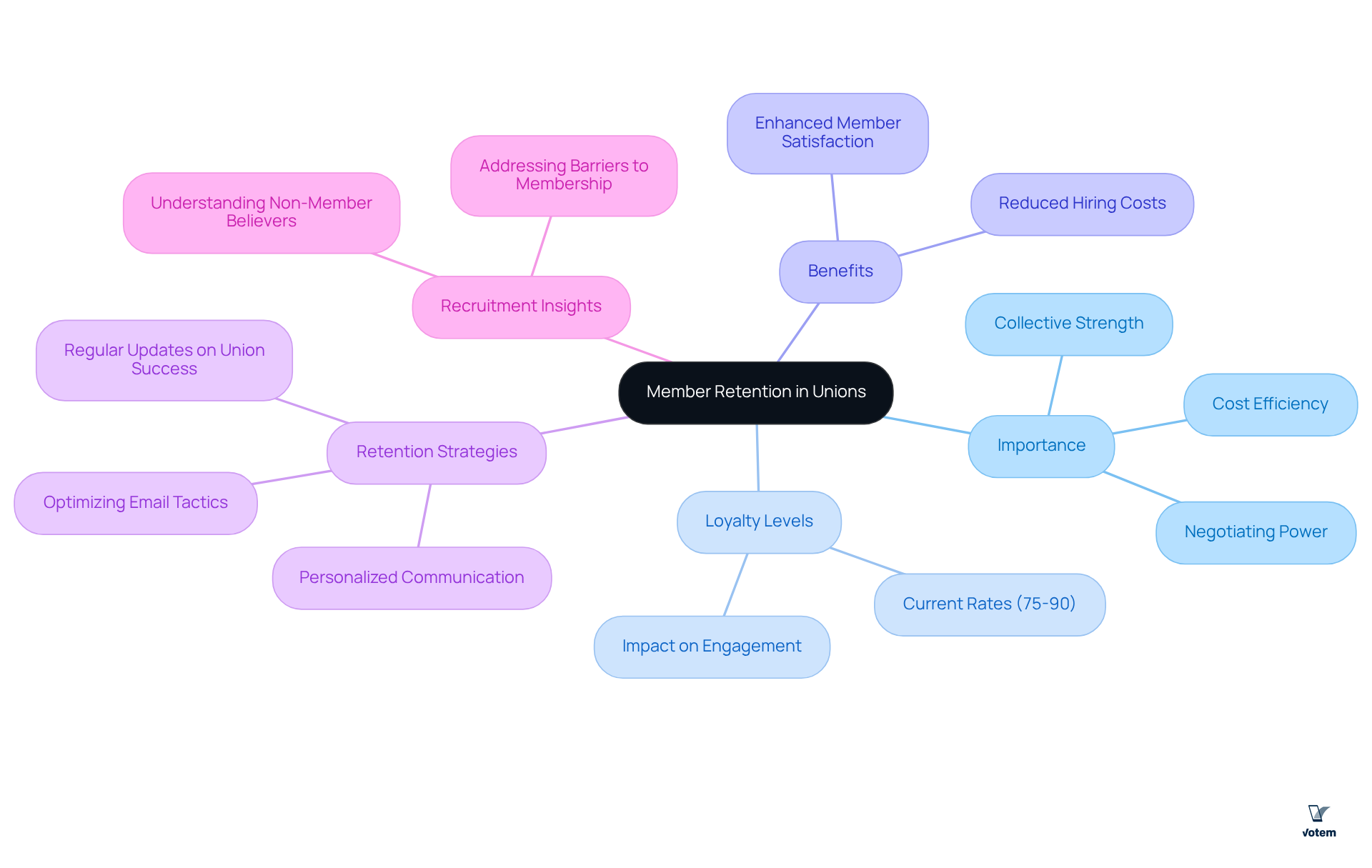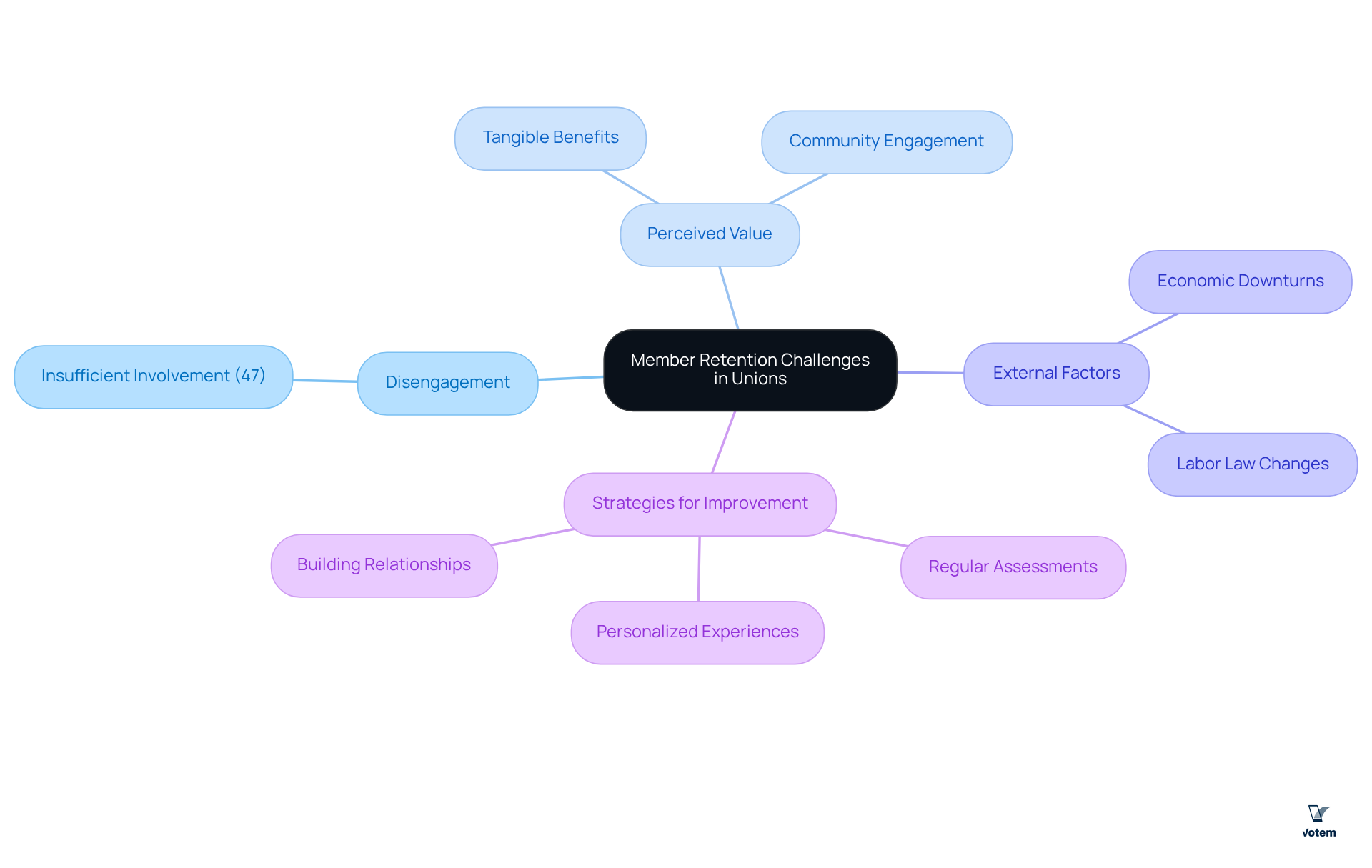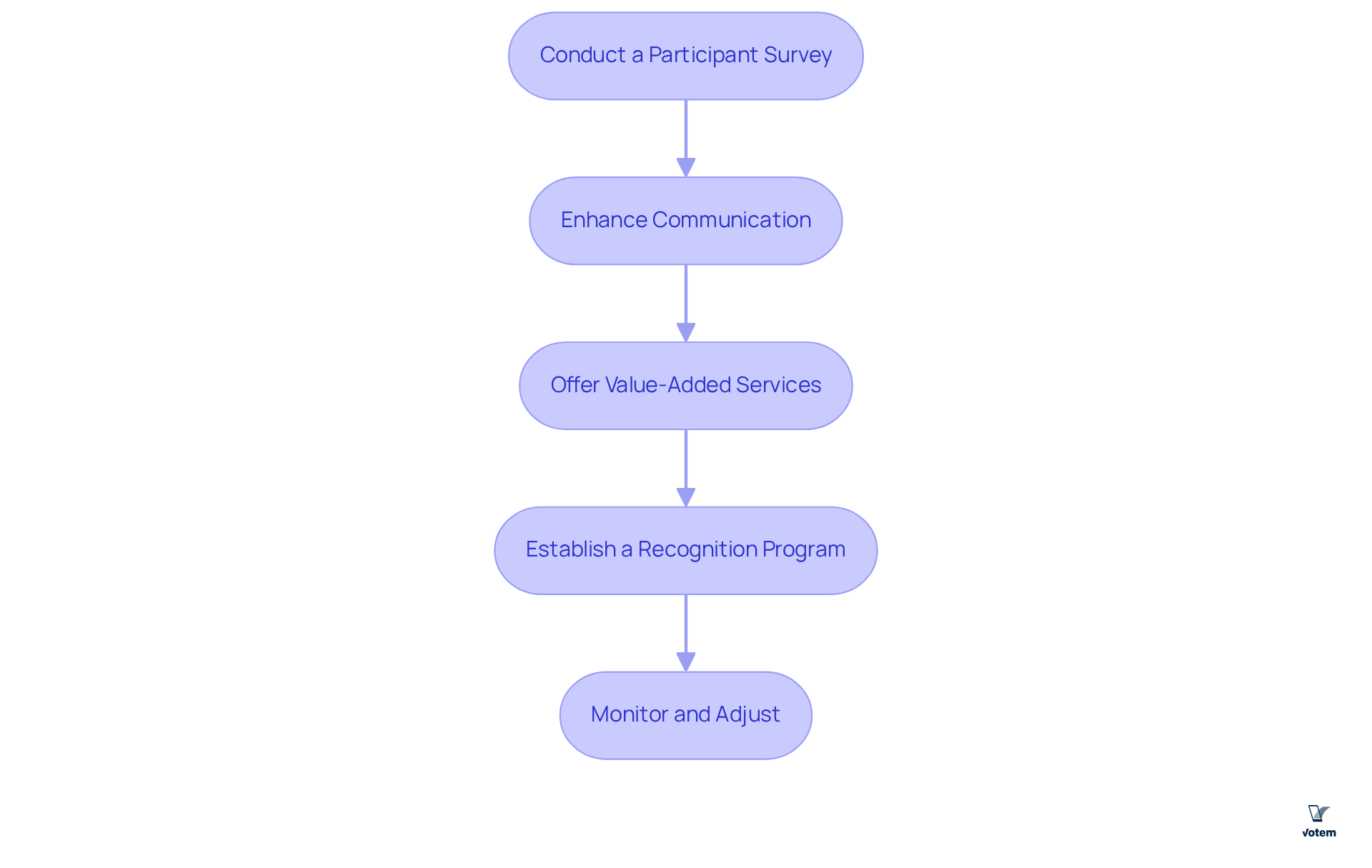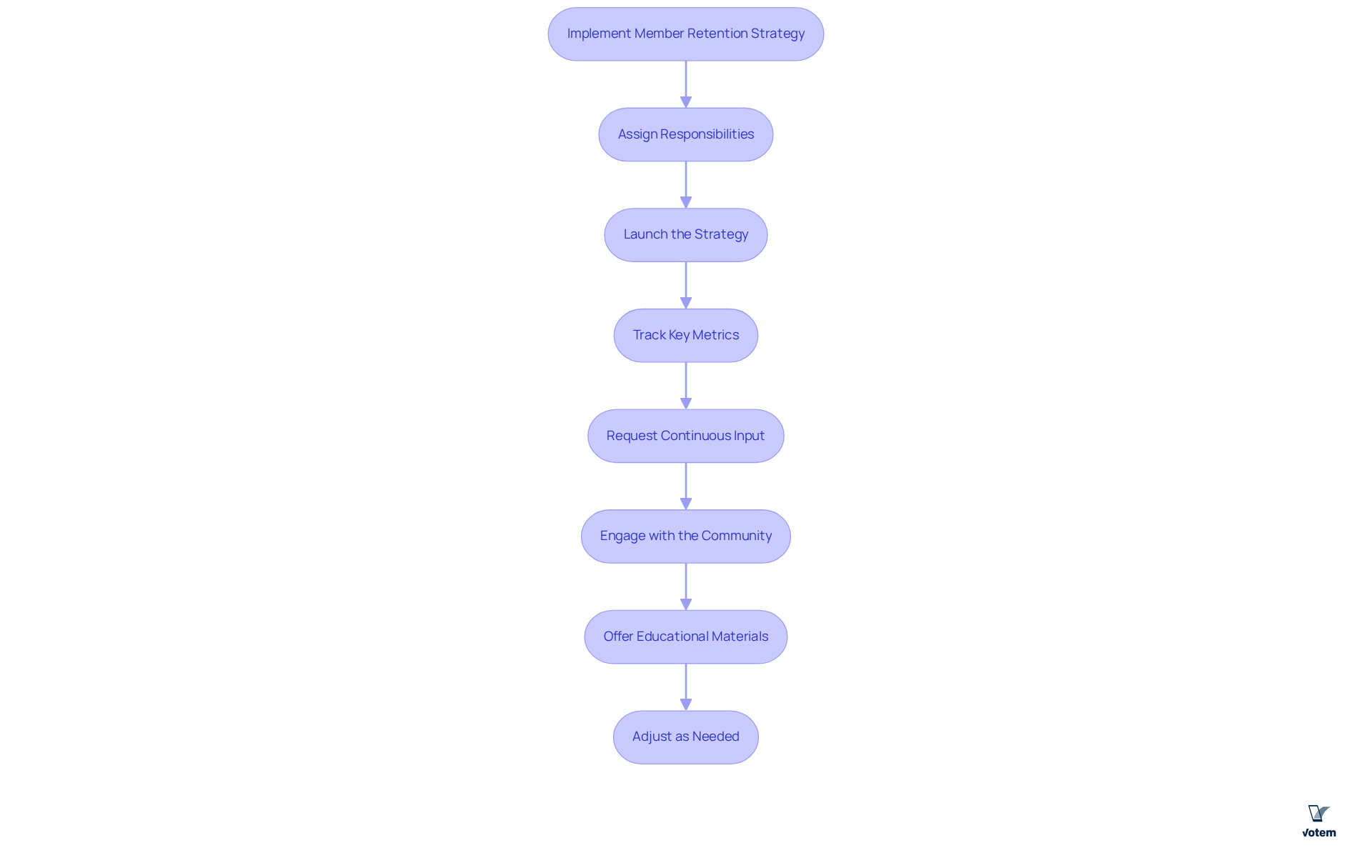Overview
To develop a robust member retention strategy, organizations must prioritize:
- Conducting participant surveys
- Enhancing communication
- Offering value-added services
- Establishing recognition programs
- Continuously monitoring and adjusting their strategies
Understanding member needs is crucial. By maintaining engagement through personalized experiences and regular feedback, unions can significantly improve retention rates. This approach ultimately fosters stronger loyalty and involvement within unions, creating a more vibrant community.
Furthermore, organizations should consider the impact of these strategies on overall member satisfaction. Engaging members through tailored communication and recognizing their contributions can lead to a deeper connection with the union. In addition, the implementation of value-added services can provide members with tangible benefits, reinforcing their decision to remain active participants.
Ultimately, a commitment to understanding and responding to member needs will not only enhance retention but also cultivate a culture of loyalty and engagement. By continuously refining these strategies based on feedback and changing member expectations, unions can ensure their relevance and effectiveness in fostering a strong, united membership.
Introduction
A thriving union relies heavily on its ability to retain members. However, many organizations struggle to maintain participant loyalty amidst growing competition and disengagement. With retention rates fluctuating significantly, understanding the critical components of a successful member retention strategy is essential for unions aiming to enhance their influence and effectiveness. How can unions not only keep their current members engaged but also foster a sense of belonging that translates into increased participation and satisfaction?
Furthermore, it is crucial to recognize that the challenges faced by union leadership are multifaceted. By addressing these challenges head-on, unions can implement effective strategies that not only retain members but also cultivate a vibrant community. This article will explore the vital elements of member retention, providing insights that will empower union leaders to take decisive action in fostering loyalty and engagement among their members.
Understand the Importance of Member Retention in Unions
A solid member retention strategy is vital for organizations, as it establishes a stable membership foundation essential for negotiating better salaries, benefits, and work environments. In 2022, most associations reported participant loyalty levels ranging from 75% to 90%, indicating a competitive landscape for sustaining support. Elevated loyalty levels signify participant satisfaction and engagement, which can significantly boost involvement in collective activities and initiatives. For instance, associations that maintain a membership rate of 80% or higher can effectively leverage their collective strength during negotiations, leading to more favorable outcomes.
Furthermore, retaining individuals minimizes the costs associated with hiring and training, allowing organizations to allocate resources more efficiently. By prioritizing a member retention strategy—such as personalized communication and optimizing email tactics—leaders can foster loyalty and commitment among their constituents. Understanding why non-member believers remain outside the fold can also inform , ultimately enhancing the organization’s overall effectiveness and influence. This strategic approach not only bolsters membership but also empowers unions to navigate challenges more adeptly.

Identify Challenges in Member Retention for Unions
Unions encounter significant challenges in retaining participants, primarily due to disengagement, the perceived value of affiliation, and competition from other organizations. Notably, statistics reveal that 47% of participants cite insufficient involvement as a key reason for non-renewal. In contrast, 81% of respondents indicated that their engagement levels have either increased or remained stable. This highlights an urgent need for organizations to while also recognizing the potential for improvement. When individuals fail to perceive tangible benefits from their association, feelings of detachment can ensue, leading to elevated attrition rates. Moreover, external factors such as economic downturns and shifts in labor laws further complicate retention efforts.
To effectively combat these challenges, organizations must prioritize regular assessments of member satisfaction and adapt their strategies accordingly. Successful unions have adopted member-centric approaches that focus on personalized experiences and community engagement. For example, organizations that have developed strong value propositions and communicated them effectively have witnessed improved retention rates. Additionally, tailoring offerings and experiences, along with formulating a participant engagement strategy, can significantly enhance loyalty. By concentrating on building relationships and demonstrating the value of belonging, unions can foster stronger bonds and loyalty among their members, ultimately leading to increased involvement and satisfaction.

Develop a Step-by-Step Member Retention Strategy
To develop an effective member retention strategy, consider the following steps:
- Conduct a Participant Survey: Collect feedback from existing participants to comprehend their needs, expectations, and satisfaction levels. This data is essential, as retention rates can fluctuate considerably; for example, one association reported a in 2022, emphasizing the urgent need for an [effective member retention strategy](https://votem.com/4-strategies-for-retention-of-members-in-unions/). Use the insights gained to identify areas for improvement and tailor your approach accordingly.
- Enhance Communication: Establish regular communication channels to keep individuals informed about organization activities, benefits, and achievements. Utilize newsletters, social media, and meetings to foster engagement. Numerous organizations have discovered that steady communication, such as focused messaging and frequent updates, aids in sustaining participant interest and loyalty, especially among those who might feel detached.
- Offer Value-Added Services: Provide services that enhance the user experience, such as training programs, workshops, and networking opportunities. Highlight the benefits of membership to reinforce its value. Organizations that concentrate on providing concrete advantages frequently observe enhanced retention rates, which can be attributed to their member retention strategy that emphasizes the direct benefits of participant engagement.
- Establish a Recognition Program: Acknowledge and celebrate contributions and achievements of participants. This can include awards, shout-outs in newsletters, or special events to honor committed individuals. Acknowledging individuals not only enhances morale but also fortifies their bond with the organization, increasing the likelihood of their continued involvement.
- Monitor and Adjust: Regularly evaluate the effectiveness of your strategies for keeping individuals through feedback and metrics. Be prepared to adjust your approach based on what works and what doesn’t. Comprehending the reasons individuals exit unions is essential; a member retention strategy that includes monitoring churn rates can offer significant insights into satisfaction levels and areas requiring focus, enabling unions to proactively tackle possible problems.

Implement and Monitor Your Member Retention Strategy
Once you have developed your member retention strategy, it’s time to implement it.
- Assign Responsibilities: Designate team members to oversee different elements of the preservation strategy. This ensures accountability and fosters clear communication throughout the organization.
- Launch the Strategy: Implement your engagement initiatives with a well-defined plan that includes timelines and expected outcomes. Clearly convey these changes to everyone involved to generate excitement and encourage support.
- Track Key Metrics: Monitor retention rates, participant engagement levels, and feedback from surveys to evaluate the effectiveness of your strategies. Pay close attention to churn indicators, such as inactive primary accounts and low transaction volumes. Utilize tools like CRM systems to effectively, enabling informed decision-making.
- Request Continuous Input: Regularly engage with individuals to gather insights on their experiences and perceptions of the union. This proactive outreach can help identify emerging challenges and opportunities for enhancement, ensuring that individuals feel valued and heard. Consider implementing personalized engagement strategies to deepen these interactions.
- Engage with the Community: Actively participate in local initiatives to strengthen relationships among participants and demonstrate your commitment to the community. This engagement can foster deeper connections and enhance loyalty among participants as part of a member retention strategy.
- Offer Educational Materials: Customize educational materials to align with individuals’ lifecycle stages, assisting them in navigating their financial choices and improving their overall experience with the union.
- Adjust as Needed: Maintain flexibility and be willing to adapt your strategies based on the feedback and data collected. Continuous improvement is essential for sustaining high retention rates and is a key component of an effective member retention strategy that fosters long-term member loyalty.

Conclusion
A robust member retention strategy is essential for unions to thrive and achieve their goals. By focusing on retaining members, organizations can create a strong foundation that not only enhances their negotiating power but also fosters a sense of community and belonging among participants. This emphasis on retention ultimately leads to improved satisfaction, engagement, and loyalty, which are crucial for the long-term success of any union.
Key points discussed throughout the article emphasize the importance of understanding the challenges unions face in retaining members, such as disengagement and competition. By implementing a step-by-step retention strategy that includes:
- Conducting surveys
- Enhancing communication
- Offering value-added services
- Recognizing contributions
unions can effectively address these challenges. Furthermore, monitoring and adjusting these strategies based on feedback ensures that organizations remain responsive to their members’ needs.
In a competitive landscape, the significance of member retention cannot be overstated. By prioritizing these strategies, unions can not only bolster their membership numbers but also empower their members, leading to a more engaged and committed community. Organizations are encouraged to take action now, implementing these best practices to enhance member satisfaction and secure a brighter future for their unions.
Frequently Asked Questions
Why is member retention important for unions?
Member retention is crucial for unions as it establishes a stable membership foundation, which is essential for negotiating better salaries, benefits, and work environments.
What was the reported loyalty level among associations in 2022?
In 2022, most associations reported participant loyalty levels ranging from 75% to 90%.
How does elevated loyalty impact member involvement?
Elevated loyalty levels signify participant satisfaction and engagement, which can significantly boost involvement in collective activities and initiatives.
What membership rate allows associations to leverage their collective strength effectively?
Associations that maintain a membership rate of 80% or higher can effectively leverage their collective strength during negotiations.
What are the benefits of retaining members for organizations?
Retaining individuals minimizes the costs associated with hiring and training, allowing organizations to allocate resources more efficiently.
What strategies can leaders use to foster member loyalty?
Leaders can prioritize member retention strategies such as personalized communication and optimizing email tactics to foster loyalty and commitment among their constituents.
How can understanding non-member beliefs aid unions?
Understanding why non-member believers remain outside the fold can inform recruitment efforts, ultimately enhancing the organization’s overall effectiveness and influence.
List of Sources
- Understand the Importance of Member Retention in Unions
- Growing, engaging and retaining union membership — Independent Education Union Victoria Tasmania (https://ieuvictas.org.au/news/growing-engaging-and-retaining-our-unions-membership)
- How do we retain more members in our unions? – TUC Digital Lab (https://digital.tuc.org.uk/how-do-we-retain-more-members-in-our-unions)
- Effective Email Campaigns for Union Member Retention – Six Degrees Digital Media (https://sixdegreesdigitalmedia.com/effective-email-campaigns-for-union-member-retention)
- The importance of member retention — Independent Education Union Victoria Tasmania (https://ieuvictas.org.au/news/the-importance-of-member-retention)
- The Future of Unions (https://news.gallup.com/opinion/polling-matters/392027/future-unions.aspx)
- Identify Challenges in Member Retention for Unions
- [Report] Why Members Don’t Renew and How to Prevent It (https://blog.imis.com/member-retention-report)
- Boost Member Retention: Top 4 Strategies in 2025 (https://interface.ai/blog/boost-member-retention-top-4-strategies)
- Member Retention Secrets: Building Loyalty in a Competitive Landscape (https://memberxp.com/member-retention-secrets-building-loyalty-in-a-competitive-landscape)
- Education Department hosts class on so-called “right to work” (https://smart-union.org/education-department-hosts-class-on-so-called-right-to-work-to-boost-member-engagement-organizing)
- 2025: What are the challenges and opportunities for the trade union movement? (https://ilo.org/resource/news/2025-what-are-challenges-and-opportunities-trade-union-movement)
- Develop a Step-by-Step Member Retention Strategy
- Three strategies to improve your union’s member retention | Alex White (https://alexwhite.org/2023/04/three-strategies-to-improve-your-unions-member-retention)
- How do we retain more members in our unions? – TUC Digital Lab (https://digital.tuc.org.uk/how-do-we-retain-more-members-in-our-unions)
- NewsGuild plans member surveys | The NewsGuild – TNG-CWA (https://newsguild.org/newsguild-and-nabet-plan-member-surveys)
- Union conducting 2024 member survey (https://mgeu.ca/news-and-resources/the-latest/news/2299/union-conducting-2024-member-survey)
- Implement and Monitor Your Member Retention Strategy
- Igniting Loyalty: Innovative Strategies for Skyrocketing Member Retention (https://earnup.com/member-retention)
- Improve Credit Union Member Retention with 3 Techniques — Ovation Ventures (https://ovationventures.com/blog/financial-wellbeing-the-new-frontier-of-customer-engagement-mmxpl-l75ex-zlc8f)
- How Credit Unions Can Turn Digital Insights into Member Retention Power (https://fintilect.com/resources/insights/credit-unions-digital-insights-member-retention)
- Member Retention Secrets: Building Loyalty in a Competitive Landscape (https://memberxp.com/member-retention-secrets-building-loyalty-in-a-competitive-landscape)
- The importance of member retention — Independent Education Union Victoria Tasmania (https://ieuvictas.org.au/news/the-importance-of-member-retention)

